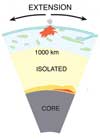 |
The Plate Theory of Volcanism |
Gillian R. Foulger
Department of Earth Sciences, Durham University, Science Laboratories, South Rd. DH1 3LE, UK; g.r.foulger@durham.ac.uk
See also: https://en.wikipedia.org/wiki/Plate_theory_(volcanism)
Statement of the hypothesis
The Plate Hypothesis proposes that volcanic anomalies such as Hawaii, Iceland and Yellowstone are all features of plate tectonics. Specifically, the hypothesis proposes that anomalous volcanism occurs in response to lithospheric extension which permits melt to escape to the surface. This melt may pre-exist and, if the extension is sufficient to thin the lithosphere, be supplemented by additional melt formed during isentropic asthenosphere upwelling.
The mere presence of melt in the crust or mantle is not sufficient to explain volcanism. Lithospheric extension is required for magmatism to occur. The processes that cause lithospheric extension are the driving factors. Melt escape to the surface is passive.
Clarification of the main issues
The location of anomalous volcanism is governed by the spatial stress field in the plate. This is a function of factors such as plate-boundary forces, plate cooling, sediment loading at the edges of continents, isostatic adjustments and warping as the lithosphere approaches a subduction zone.
Time-progression of volcanism forming linear volcanic chains, or other spatial distributions of eruptives, result from spatial evolution of the extensional stress field. This, in turn, results from evolution of the factors that govern the plate stress field. For example, the subduction of a spreading ridge, the collision of two continents, or formation of a new subduction zone are all expected to alter plate stress fields. Because plate tectonics on the surface of Earth is a closed system, a change in one plate boundary will affect the entire global system.
Examples include the time-progression of silicic volcanism in the Yellowstone region. This has been suggested to result from easterly migration of the locus of greatest extension along the Eastern Snake River Plain, the northerly boundary of the Basin Range Province [Foulger et al., 2015].
The Plate Hypothesis predicts that volcanoes of the Hawaiian island/seamount chain erupted at a region of extension in the Pacific Plate. This region of extension has remained approximately stationary relative to Earth’s geomagnetic field for the last ~50 Myr. During this time the physical plate itself drifted to the NW, transporting volcanoes with it. As each volcano is removed from the geo-stationary region of extension, it wanes in activity and finally becomes extinct.
The volume of melt produced is governed by the availability of pre-existing melt, the amount of extension, and the fusibility of the source.
Pre-existing melt is widespread in the mantle and thus magmatism can occur in the presence of only minor lithosphere extension with little or no isentropic upwelling. Such magmatism will usually be relatively minor in volume, e.g., at Cameroon and Pitcairn. Large volumes may be erupted if major, pre-existing melt reservoirs are tapped, e.g., the Great Dyke (Zimbabwe) and Bushveld complex (South Africa) [Silver et al., 2006].
Where lithospheric extension and thinning is severe, asthenosphere upwelling occurs and melt may be generated by isentropic decompression. Where this is extreme, massive volumes may be produced and form flood basalts. This process is responsible for magmatism in continental rifts, e.g., the Rhine Graben and the East African Rift. Volcanic margins form where thick continental lithosphere is extended to catastrophic failure and continental breakup occurs, e.g., in the North Atlantic Ocean [e.g., Simon et al., 2009].
Geochemistry: The Plate Hypothesis predicts that anomalous volcanism is shallow-sourced and that its geochemistry can be explained by shallow processes. This includes unusually high-3He/4He ratios. It further predicts that no geochemstry requires a source in the deep mantle. |
|
Other observations: Lithospheric extension results from many different processes. The volume of melt available also varies. Both these factors may change with time where volcanism is prolonged. The implications of these factors are as follows:
- Surface deformations associated with volcanism are expected to vary between different volcanic regions;
- The volcanic rate may vary with time in an unsystematic way;
- Where kinematic conditions are stable and extension localized, time-progressive volcanic chains may develop;
- Where extension is distributed over a wide area, and/or where local block kinematics are complex, volcanism may be scattered and systematic time-progressions absent;
- Systematically high temperatures are not expected though temperatures may be elevated if melt is tapped from unusually deep in the surface thermal boundary layer, i.e. the top ~200 km of the crust and mantle.
Summary
The Plate Hypothesis considers volcanism at melting anomalies to be shallow-sourced and a second-order manifestation of a rich and complex plate tectonics – one that operates in the real, inhomogenous, complex geological Earth and not the simple world of first-order conceptual theory.
Additional links
Discussions of specialist aspects of Plate theory.
References
-
Foulger, G. R., R. L. Christiansen, and D. L. Anderson (2015), The Yellowstone "hot spot" track results from migrating basin-range extension, in The Interdisciplinary Earth: A Volume in Honor of Don L. Anderson, edited by G. R. Foulger, Lustrino, M., King, S.D., Geological Society of America Special Paper 514, 215-238, Boulder, CO.
-
-
last updated 18th
November, 2021 |
